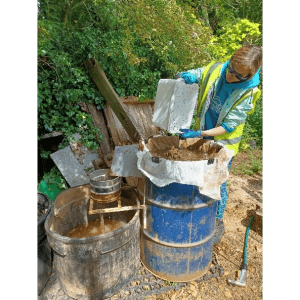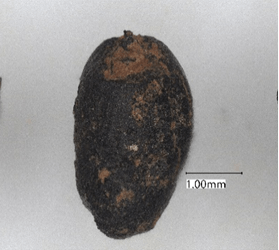
A recent pilot study investigated the archaeobotanical remains from our medieval site at Lower Hazel in South Gloucestershire. Charred botanical specimens were extracted from soil samples using flotation methodology and then analysed under a microscope to identify them and provide a better understanding for the use of plants in the diet and agriculture of the medieval period*.
Plants, as biological organisms will decompose with time. Despite this, they can often survive within the archaeological record in myriad ways. The study of plant remains from archaeological sites is known as archaeobotany, and seeks to identify the external morphological features of, for example seeds, through a comparison of the ancient remains with their modern plant equivalents.
Understanding the correlation between people, plants and the environment in which they exist is one of the main aims of archaeobotanical analysis. Plant assemblages can be used to answer questions relating to food such as what certain groups of people were eating and trade in food commodities, as well as questions relating to agriculture including differing approaches to crop cultivation, scales of production, and how these affect the regional flora. By exploring how these vary throughout pre-history and history we can gain better insight into this ever-changing relationship, which is increasingly important when considering existing fears surrounding climate change caused by human activity.
Plant remains range from tiny microfossils such as pollen, to macrofossils, for example grains and seeds. Carbonised plant remains are those most commonly encountered on sites in the UK due to the climate here. These burnt assemblages provide an avenue through which to explore past anthropogenic action, such as crop processing or food preparation processes. The questions that can be asked are dependent upon the site being excavated due to biases in preservation*.

The medieval period characterises a significant stage in British history for the development of diet and agricultural practices in which cultivation of fruits and vegetables broadened and there was a shift from spelt, barley and emmerged as the main cereal crops, to barley, wheat, oat and rye which we still grow today. In addition, disparities in food provisions between different societal classes increased as connections between towns and rural areas developed.
The study was designed to address the lack of any previous formal environmental investigation at Lower Hazel, and so, soil samples were taken during excavations in May 2022, for the extraction and analysis of any plant remains. Systematic flotation which separates the soil from the botanical specimens, was conducted on site using a siraf-style flotation barrel and sieve meshes of differing sizes in which to ‘catch’ the plant remains. These were then brought to the laboratory for analysis*.
Although only a small study, it has nonetheless resulted in some interesting contributions to knowledge about the site at Lower Hazel during this period*.

The crop plants found in the samples are indicative of the medieval period (Carruthers and Hunter Dowse 2019:132): wheat (Triticum turgidum/aestivum), and oat (Avena sp.). There is some uncertainty as to which free-threshing wheats are present since the chaff is absent in these samples and this is vital for diagnostic purposes. This is a common problem for archaeobotanical investigation since processing waste for free-threshing wheats would likely be created where it was harvested rather than near settlement buildings, thus rendering it less likely to appear in the archaeological record. The reason for difficulty of identification is due to the distortion of grains which happens when they are exposed to heat. Furthermore, since waste products from cereal processing were utilised in other ways such as for animal fodder or bedding for both humans and animals, as well as in building materials like thatch or daub, they would likely only become charred in a few circumstances such as when used for fuel or tinder.
A single oat specimen was found in the samples, analysed and later radiocarbon dated using the Bristol Radiocarbon Accelerator Mass Spectrometry (BRAMS) facility. The result was an uncalibrated date range of 1031- 1162CE with a 95.4% probability which helped confirmed the theory that the site was in use during the Anarchy period*.
A specimen of burnt straw as well as tiny fragments of daub were found in samples <2> and <3>. These are likely the materials used for the building structure. The lack of further burnt straw fragments could serve as evidence for the burning down of the property during the Anarchy period since it would indicate that the fire was of an intensity such that no further remains of the thatched roof were left*.
Fields during the medieval period were sown with combinations of cereals which increased the likelihood of a successful harvest of one sort or another, for example ‘maslin’ (a mixture of rye and wheat) which was sown in winter, and ‘dredge’ (a mixture of oats and barley) which was sown in spring. The individual properties of different cereals often shaped the ways they were used. Just as today, free-threshing wheat was favoured for bread making since it produced the whitest and lightest loaf. Rye produced darker and more dense loaves but was able to survive in more hostile environments. Barley and oats were also used in bread making but both were more commonly used in ale production and for fodder. In addition to their role in medieval diet, cereal crops also had a wide range of other uses which included cereal straw as bedding, in building materials such as thatch and daub, temper for ceramics and as fuel.
Archaeobotanical evidence shows that medieval fields also contained a diverse range of arable weed floras. These vary depending upon factors such as tillage methods and soil fertility. Understanding whether they are annual or biennial as well as their ecology allows us to identify field environments from which we can better comprehend techniques of production reconstruct seasonal sowing and crop rotation patterns.
Previous finds from the site by the Thornbury Archaeology Group include large deposits of charred free-threshing grains*. These are morphologically the same as grains retrieved in this investigation which could be seen as evidence that the site is a Norman hunting lodge or Norman manor* since historical documentation indicates that wealthier households consumed a higher proportion of wheat and rye, whereas the poor, ate proportionately more barley. Further research on site could test this theory through examining crop ratios as suggested by Bogaard et al.
* Harman, C. (2023) ‘Planting Anarchy: Exploring archaeobotanical remains from the Lower Hazel 2022 excavation’, Undergraduate dissertation, University of Bristol, Bristol. Unpublished
**Charred Triticum aestivum/T. turgidum. Photographed usinging an AHRC funded Keyence VHX7000 3-D digital microscope (AHRC award AH/V011758/1) at Fort Cumberland Laboratories, Historic England
Text and photos taken from an undergraduate dissertation by Charlotte Harman, submitted to the University of Bristol in May 2023.
Author
Charlotte Harman is a MPhil student in archaeology focusing on archaeobotany
